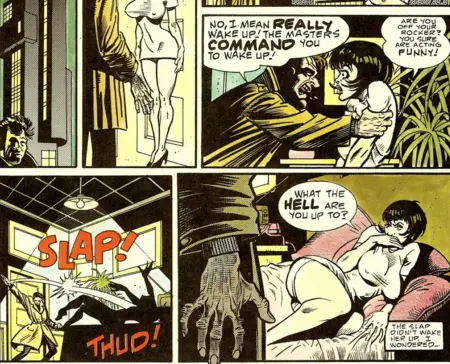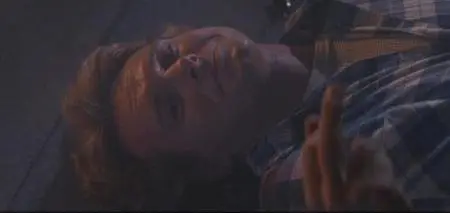You've probably seen it at this point, the now infamous Pepsi commercial in which Kylie Jenner (a person famous merely for being rich) mends all social and political ails by handing a cop a cold can of tooth-rotting soda. If you haven't borne witness to this tone-deaf monstrosity, never fear, because someone out there in the internetosphere made a parody that sums up the ad's message neatly (whether or not the ad people behind the TV spot knew this was the actual message or not). Check it out:
While discussing Pepsi's ongoing PR nightmare with my wife and our friend, I pulled up this video so they could savor its twelve seconds of pointed brilliance. Now, the key here is that our friend had never seen the film from which this clip takes its inspiration—John Carpenter's endlessly entertaining 1988 satire They Live. And yet, despite the fact she'd never witnessed the glory of this movie, she knew the reference immediately. And I think it's safe to say that most people do. The images of these weird, zombie-esque aliens with insectile, puckered-asshole eyes standing before plain black and white signs instructing us to OBEY, CONSUME, YIELD, WATCH TELEVISION, MARRY AND REPRODUCE, and BUY have become synonymous with the idea of resistance, of seeing beyond the façade of capitalism, and staring class disparity square in the face.
It's no surprise to me, then, that the maker of this parody video went to They Live as a source for further satirization, because the Pepsi ad really does seem like something the creatures from the film would come up with: a rich white girl reaches across lines of division with a corporate soft drink and magically heals all civil unrest—which, we must infer, is frivolous in the face of life's simpler pleasures (like corporate soft drinks and partying in the street!). We shouldn't care about politics, the ad implies, we should just all continue getting along and drinking pop and having fun.
This ad and its They Live parody, moreover, pretty much sum up our current political climate, and thus now is a great time to revisit this Reagan-era masterpiece (i.e., if you haven't seen it, DO IT NOW!). But of course, one must not give Carpenter all the credit, which would ignore the source material behind his fantastic film: the short story "Eight O'Clock in the Morning" by science fiction author Ray Nelson, first published in The Magazine of Science Fiction & Fantasy, November 1963—25 years before They Live hit theaters—and anthologized numerous times since (including in Tomorrow's TV). In acknowledging Nelson's inventing the narrative that Carpenter popularized, though, the question does arise (as it tends to do in these Book vs. Film columns): does the short story pack the same wallop as the movie upon which it's based? And what of the short comic book adaptation, released in 1986 by Eclipse Comics under the Alien Encounters series? What function does it play in this narrative's journey from page to screen?
As we also do in these columns, we're about to find out...
The Original
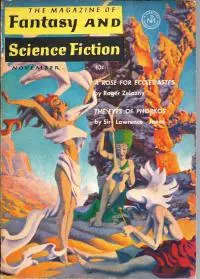 Overall, Nelson's story mirrors Carpenter's adaptation from a skeletal standpoint: a man named Nada (a zero, a nobody, an average schmo), discovers that the world we see everyday is not what it seems, that the buildings, posters, televisions, and even some of the people before us are merely a smokescreen, a veil of normality covering the truth: that a race of multi-eyed snake creatures not only control the earth, but our very thoughts and impulses as well. The aforementioned OBEY, CONSUME, YIELD, etc. directives appear everywhere, and once he understands the creatures (here called the Fascinators) hypnotize humanity into complacence in order to literally consume them, he sets about stopping this longstanding occupation. He figures out that television is the Fascinators' primary weapon, and after dispatching the creature before the cameras, he leaves the corpse in its chair, stands off camera, imitates the Fascinator and tells people to wake up, and to kill the creatures on sight. (If you watch Doctor Who, you've seen this exact ending play out with "The Silence.") But Nada doesn't live long enough to see the revolution come to full fruition: he was told by a Fascinator disguised as a cop that his heart would stop at exactly eight o'clock in the morning, and that's exactly what happens.
Overall, Nelson's story mirrors Carpenter's adaptation from a skeletal standpoint: a man named Nada (a zero, a nobody, an average schmo), discovers that the world we see everyday is not what it seems, that the buildings, posters, televisions, and even some of the people before us are merely a smokescreen, a veil of normality covering the truth: that a race of multi-eyed snake creatures not only control the earth, but our very thoughts and impulses as well. The aforementioned OBEY, CONSUME, YIELD, etc. directives appear everywhere, and once he understands the creatures (here called the Fascinators) hypnotize humanity into complacence in order to literally consume them, he sets about stopping this longstanding occupation. He figures out that television is the Fascinators' primary weapon, and after dispatching the creature before the cameras, he leaves the corpse in its chair, stands off camera, imitates the Fascinator and tells people to wake up, and to kill the creatures on sight. (If you watch Doctor Who, you've seen this exact ending play out with "The Silence.") But Nada doesn't live long enough to see the revolution come to full fruition: he was told by a Fascinator disguised as a cop that his heart would stop at exactly eight o'clock in the morning, and that's exactly what happens.
If you've never read this story, that's understandable. It's a bit difficult to obtain these days, but you can find copies of the original Fantasy & Science Fiction issue featuring the tale, as well as some of the anthologies it's appeared in. There are a few blogs out there that have, ahem, taken the liberty of publishing the story online, and you can seek those out, if you so choose. Or, you could have a listen to the tale on the SFFaudio Podcast, which features a full narration by Gregg Margarite as well as an interview with Nelson following the reading. During this latter portion of the podcast, co-host Margarite describes the prose as terse and procedural, while the writer himself uses the term "bare bones." In other words, if you're looking for in-depth explorations of Nada's thoughts and feelings, you're not going to find them here. Nelson's hero (and I use that term over protagonist intentionally) is all action: once he realizes that human beings essentially have no free will, he basically starts killing Fascinators left and right, and in most gruesome fashions: bludgeoning one in an alley with a brick and slitting the throats of two others before obtaining one of their poison dart guns and blowing more away with that weapon. All we know of Nada's emotional landscape is that he's horrified by the Fascinators and their control of Earth, and he's willing to do whatever it takes to wake up his species.
In some ways, this no-nonsense storytelling works to the narrative's advantage: its ultimate aim is to use science fiction and adventure as a subversive agent, a pointed tackling of American capitalism's numbing effect on American people, disguised as a "frivolous" piece of escapism. In this way, "Eight O'Clock in the Morning" is quite brilliant, but Nelson takes some unfortunate and clichéd shortcuts to keep the word count low—most glaringly, Nada's understanding of a complex and sprawling alien conspiracy coming to him "in a flash" after a botched hypnotism act that somehow allows him to see beyond the veil. Arguably, the means by which Nada wakes up isn't that important, but Nelson's chosen path leaves a bit to be desired.
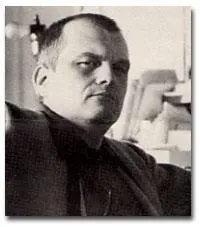 Beyond considerations of prose and literary clichés, however, Nelson's "man of action" behaves like a big, sexist brute. He begins his journey to wake up the masses with his girlfriend Lil. His tactic for waking her up? Shaking her and commanding her to "wake up," then slapping her around when she expresses utter confusion at his actions. When she still fails to wake up, he ties her up to a chair, stuffs a gag in her mouth, and leaves her that way, never to show up in the narrative again. During the SFFaudio Podcast interview, Nelson states that Nada's name, lack of backstory, and total absence of emotional landscape were all by design, meant to allow the reader to imprint themselves onto the hero. So if you want to live in the skin of a dude casually brutalizing his girlfriend as a means of getting her to understand something he hasn't explained to her at all (rather than, say, taking her to the hypnotist show that somehow, magically made him understand the real terror facing humanity and seeing if Lil might experience the same awakening), then this is the story for you!
Beyond considerations of prose and literary clichés, however, Nelson's "man of action" behaves like a big, sexist brute. He begins his journey to wake up the masses with his girlfriend Lil. His tactic for waking her up? Shaking her and commanding her to "wake up," then slapping her around when she expresses utter confusion at his actions. When she still fails to wake up, he ties her up to a chair, stuffs a gag in her mouth, and leaves her that way, never to show up in the narrative again. During the SFFaudio Podcast interview, Nelson states that Nada's name, lack of backstory, and total absence of emotional landscape were all by design, meant to allow the reader to imprint themselves onto the hero. So if you want to live in the skin of a dude casually brutalizing his girlfriend as a means of getting her to understand something he hasn't explained to her at all (rather than, say, taking her to the hypnotist show that somehow, magically made him understand the real terror facing humanity and seeing if Lil might experience the same awakening), then this is the story for you!
The Comic
As previously mentioned, a comic book adaptation of "Eight O'Clock in the Morning," retitled "Nada," appeared in 1986 within the pages of Alien Encounters, two years before They Live's release. Nelson himself wrote the script, and Bill Wray provided the art. As with the original short story, physical copies of the issue containing "Nada" can be a bit tricky to locate, but also like the story, there are certain blogs out there that have, ahem, graciously reprinted the graphic story in its entirety.
All in all, "Nada" is "Eight O'Clock in the Morning" in comic book format. The stories are virtually identical, with narration switching from third to first person, and a few dialogue changes here and there. The social commentary feels less pointed, but only slightly. Nelson and/or Wray notch up the graphic violence significantly here, and there's definitely a stronger comedic air to the narrative, utilizing over-the-top shoot-em-up scenes to give the proceedings a more pulpy texture. (The hilarious button closing off They Live—in which a woman realizes her man is one of THEM during copulation—appears here.) Sadly, Nada's brutalization of Lil remains intact, and adding insult to injury, it's hyper-sexualized to boot.
The artwork overall is interesting, despite this, utilizing a noir-inspired color palette and dichotomy of shadow and light. Seek the comic out if you're a fan of the film, as its influence on Carpenter—with its hail of bullets, dark sense of humor, and quipping hero—is rather apparent, even if the social commentary is toned down a bit, and Nada's brutalization of Lil is far more extreme.
Now, speaking of Carpenter: does he make the same missteps as Nelson in "Eight O'Clock in the Morning" and Nelson & Wray in "Nada?"
Put on your sunglasses, and we'll see...
The Film
There's a short answer to the above question, and it's no. But, we can't very well leave it at that, now can we?
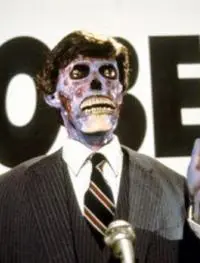 Credited for the screenplay as Frank Armitage for some reason, one of Carpenter's first changes to the story concerns the hero: in They Live, Nada is just that, both literally and figuratively. In both short story and comic, we know that the character's first name is George, that he has a small apartment somewhere in the city, and that he has a girlfriend named Lil (who he likes to smack around, apparently), but all other blanks about this man are intentionally left unfilled so as to make him an Everyman of sorts. Carpenter strips down the character even further, only ever referring to him as Nada in the credits; moreover, the hero (played rather well by the late "Rowdy" Roddy Piper, a pro-wrestler at the height of his fame at the time) drifts into Los Angeles with a backpack and the clothes on his back. We find out later he'd been living in Denver for the last decade , but we learn almost nothing else about his past. In this way, Nada becomes a kind of wanderer, who doesn't necessarily go looking for trouble, but finds it nonetheless. The connections between him and Sergio Leone's "Man Without a Name" character (played, of course, by Clint Eastwood) are rather apparent.
Credited for the screenplay as Frank Armitage for some reason, one of Carpenter's first changes to the story concerns the hero: in They Live, Nada is just that, both literally and figuratively. In both short story and comic, we know that the character's first name is George, that he has a small apartment somewhere in the city, and that he has a girlfriend named Lil (who he likes to smack around, apparently), but all other blanks about this man are intentionally left unfilled so as to make him an Everyman of sorts. Carpenter strips down the character even further, only ever referring to him as Nada in the credits; moreover, the hero (played rather well by the late "Rowdy" Roddy Piper, a pro-wrestler at the height of his fame at the time) drifts into Los Angeles with a backpack and the clothes on his back. We find out later he'd been living in Denver for the last decade , but we learn almost nothing else about his past. In this way, Nada becomes a kind of wanderer, who doesn't necessarily go looking for trouble, but finds it nonetheless. The connections between him and Sergio Leone's "Man Without a Name" character (played, of course, by Clint Eastwood) are rather apparent.
Furthermore, Carpenter amps up the sociological aspects of the narrative, bringing the more crippling effects of 1980s rampant capitalism into the forefront. Nada himself is a victim of "hard times" (something Piper's wrestling compadre Dusty Rhodes knew all about, may he also rest in peace). He states that work dwindled to nothing after numerous banks closed in Denver, prompting him to seek employment in the City of Angels; he's treated like utter dog shit by the job placement woman and the foreman of a construction crew, despite his eagerness to work (and the fact he owns his own tools); he goes to live in a shantytown with other down-on-their luck people, including whole families hit by economic collapse. He befriends Frank (Keith David) here, and during a long discussion about the haves and have nots, the latter character utters one of my favorite lines of the film: "The Golden Rule...He who has the gold, makes the rules."
In this way, Carpenter's Nada is truly salt-of-the-earth, a working man at the very bottom rung of society. He also disagrees with Frank's pessimism, believing his chance for fortune will come eventually—in other words, Nada believes in the American Dream, and his uncovering of the alien conspiracy is both action-oriented and intellectual, because he must accept that the American Dream (and by proxy, trickle-down Reaganomics) is a total crock of shit, that the ONLY way poor people will get rich is by selling out the rest of humanity for the alien's benefit. This aspect of the narrative comes in the form of the George "Buck" Flower character, who trades his bumtown life for tuxedos and champagne, so long as he helps out Earth's true rulers. He further lays out the alien's agenda, to use up the planet's resources and move on to the next one once it's depleted—just like certain conservative factions active both in the 80s and today, who don't give a flying fuck about the environment or sustainability.
And of course, people like Nada are integral to this agenda. As the unnamed man who appears on broadcast hijackings states:
The poor and the underclass are growing. Racial justice and human rights are non-existent. They have created a repressive society, and we are their unwitting accomplices.
Nada understands all of this by the end of the film, and ultimately gives his life in order to wake up the rest of society, raising just enough strength to blow up the alien's primary satellite after suffering a gut-full of bullets. He even gives the finger to the burning satellite before finally dying, his one last fuck you to the ruling class that has kept the masses under their control (a much more epic and meaningful death than dying of a heart attack at eight in the morning just because an alien told him to, if I do say so myself).
In many ways, They Live is Carpenter's attempt to wake people up. He utilizes the basic structure of a sci-fi-action-adventure narrative, complete with gunfire, explosions, and a clear delineation between good and evil; he casts a pro-wrestler in the lead role, whose ad-libbed line "I have come here to chew bubblegum and kick ass...and I'm all out of bubblegum" came straight from the absurd world of wrestling and into the action movie quote hall of fame, right up there with Arnold Schwarzenegger's "I'll be back"; he includes another wrestling-inspired scene, in which Nada and Frank pummel each other for damn near six minutes in an alleyway, all so that Nada can convince Frank to put on the special sunglasses that allow humans to see the rich for what they really are (again, a more inspired way of lifting the veil than a botched hypnotism act). All this stuff is the box office draw, the enticement to get your butt down to the theater and see the movie. It's all right there in the film's theatrical trailer:
Sure, the sociological issues are addressed in those two minutes, but they're heavily overshadowed by all that shooting and shit blowing up, plus Nada's classic "bubblegum" line appears too. This trailer promises a kick ass good time, and the film definitely delivers on that promise—but you know, you also get a healthy dose of political satire as well, enough that, maybe, just maybe, you'll think about class disparity, police forces, and the true value of your place in society for the first time. (Or, if you're a moron alt-right neo-Nazi, you'll think it's a clandestine attack on the secret Jewish control of the world, but that's a topic for another discussion.)
As stated before, They Live has aged remarkably well since its initial release almost 30 years ago—far better than its literary and comic predecessors. The issues it tackled back in the 20th century are very much prevalent today in the 21st—as we saw with the They Live-inspired Pepsi commercial remix that began this column. Carpenter hits all the right notes with this film and makes the narrative everything it needs to be and more. Some may grouse that the action-movie elements are cheesy, that the effects are outdated, and that the iconic fight scene goes on way too long (they're wrong, by the way), but even with those complaints set aside, virtually everyone recognizes the genius of the world beyond the veil, the constant barrage of OBEY and CONSUME and MARRY AND REPRODUCE. Of course, Ray Nelson deserves every ounce of credit for this concept, but it is John Carpenter who took it and made it into something truly accessible and wonderful.
Oh...and one last thing about They Live: Lil is scrapped for Holly Thompson, who works for the TV station that houses the alien satellite that masks their existence on Earth. Nada does kidnap her after blowing away several aliens—two of them cops—so he can have a place to hide for a while. But he never slaps her around or ties her up, and he really tries to explain to her what's going on—this total stranger, i.e., NOT his girlfriend. He continues to trust her after she brains him and sends him cascading through a plate glass window and down a steep hill, and sure, he ends up killing her in the end, but only because she murdered Frank, revealing her sympathy with the aliens. She also had a gun on him with clear intent to fire (we saw her shoot Frank in the back of the head mere seconds earlier), and it was a kill or be killed situation. So, you know, there's that.

About the author
Christopher Shultz writes plays and fiction. His works have appeared at The Inkwell Theatre's Playwrights' Night, and in Pseudopod, Unnerving Magazine, Apex Magazine, freeze frame flash fiction and Grievous Angel, among other places. He has also contributed columns on books and film at LitReactor, The Cinematropolis, and Tor.com. Christopher currently lives in Oklahoma City. More info at christophershultz.com

